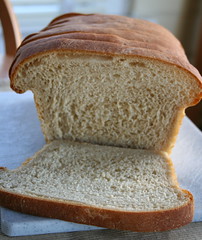December, 5, 2005 archives
bruised with adversity
apparently the blo.gs database tanked late last week, and while the site is mostly down still, the various xml flavors of the favorites lists are available. but they’ve (temporarily?) restarted the main database of blogs, so my list of favorites is truncated to only those entries that correspond to entries in the new database — but without those actually being the correct entries. so instead of jeremy zawodny leading to his site, it leads to this site.
it’s like what happened back in october, but this time they’ve (at least temporarily) reset the database completely, rather than rolling back to where it was in june.
word has it that blo.gs is still not “switched over to yahoo’s infrastructure yet,” by which i guess they mean it is running on some box under someone’s desk (figuratively, not likely literally) instead of a more properly-managed set of machines.
basic bread
 here’s another recipe rescued from the late, lamented mr. cook. i stopped buying bread a few years ago, with a few exceptions. (i also make my own tortillas. i am insane.)
here’s another recipe rescued from the late, lamented mr. cook. i stopped buying bread a few years ago, with a few exceptions. (i also make my own tortillas. i am insane.)
this recipe only approximates my current method. two big differences are that i use a kitchen-aid stand mixer for the mixing and kneading, and as you can tell from the picture, i use a loaf pan to actually bake the bread. when i make dough with this recipe, it’s usually enough for a loaf of bread and the crust for a 12" pizza. (i freeze the bread after a day, and just pop a couple of slices into the toaster for sandwiches or toast.)
- 5-6 cups bread flour
- 1 packet (or 1 tablespoon) active dry yeast
- 1 tablespoon sugar
- 2 cups warm (105°-115°) water
- 1 tablespoon salt
add the sugar, yeast, and water together, and let the yeast proof. in other words, let it get foamy on top (this usually only takes about five to eight minutes — if it doesn’t get foamy, your yeast was bad or the temperature of your water was wrong — start over!).
meanwhile, measure out the flour. this isn’t rocket science, but you’ll want to loosen the flour a bit (don’t pack it!). what i usually do is just use a small measuring cup to shake the flour from the bag into a one-cup measuring cup over the bowl i’ll be using, dumping the one-cup measuring cup when it is full. do that five times, and you'll have just about the right amount of flour. who said baking was precise?
(oh, why bread flour? it has more protein, resulting in more gluten, which makes the bread rise better. or so i’m told. who am i do doubt such rigorous scientific explanations?)
by this time, the little yeasties are certainly happy and frothy and ready to be combined with the flour. but first, mix the salt into the flour. then pour in the yeast and sugar and water, and stir it all up. you could get all fancy and put the flour in a mound, make a hollow space for the liquid, and pull in the flour from the outside of the “bowl” to combine it, but frankly you’re wasting your time. just dump in the liquid and dig in.
(oh, you can substitute whole-wheat flour for the bread flour on a one-for-one basis up to about half of the flour, if you’re into that sort of thing. my impression is that it makes the dough a little more dry, so you might need less flour overall (or more water), but honestly i haven’t really experimented with it.)
eventually you’ll get it mixed to a consistency that starts to resemble dough. at that point, dump it out of your mixing bowl on to a flat surface, and knead it (bringing in any of the last of the flour that wasn’t already mixed in). you could be precise (pushing the dough out, folding it back over itself, rotating it a quarter turn, repeat), or you can just push it around for a while. i haven’t noticed a difference, as long as you put some muscle into it. what you’re doing is creating friction between the proteins in the flour, turning them into gluten. (end of science lesson.)
you don’t want the dough to be very sticky (a little bit sticky is fine), but dough that is already stuck to something is just a magnet for other dough. you’ll probably want to wash your hands of the dough that is stuck to it from the early mixing (where not all of the flour was mixed in) at some point, and you should notice that less dough is sticking to your hand after that.
okay, once the dough is finally kneaded (it should take about ten minutes, more or less), put it in an oiled bowl, flip it over (to coat the dough with oil, and cover the bowl with oiled plastic wrap.
how do you tell when you’re done kneading? it is a very zen moment. you'll know when you’re done. or read this, but i’ve never really gotten dough that responded to that “window test” and it turns out just fine. if you really need that sort of handholding because you’re afraid of wasting five lousy cups of flour and some time, you may as well just stay over on that site.
now put the bowl in a warm place to let the dough rise. if you don’t have a warm place, turn on your oven for one minute on its lowest setting, then turn it off and put the bowl in there. don’t forget to turn the oven off!
after an hour and a half or so, the dough should double in size. take it out of the bowl, punch it down, and knead it for a minute or so, then put it back in the bowl. put the bowl back in the warm place, and let it double in size again. it shouldn’t take as long this time, probably only an hour. you can also skip this second rise, but it seems to make the bread better for me.
after the second rise (or the first, if you’re being impatient), punch the dough down again and form it into whatever form you want your bread to be in. i usually take half of the dough, make that into four roughly bun-shaped things (submarine-style, not round buns), and roll out of the other half of the dough and cut rolls from that. be creative. you can also use a quarter of the dough to make a fine pizza crust. you can even just leave each half of the dough in one big lump to make big loaves. whatever floats your boat.
put those onto lightly-greased baking pans (flat cookie-style sheets or shallow baking pans work fine), cover them (perhaps with oiled plastic wrap), and let them sit until they double in size. you may want to sprinkle some corn meal onto the baking sheets before you put the dough on to help keep them from sticking. (you left them far enough apart so they can double without bunching together, right? if you didn’t and they do, that's fine, really, you'll just need to cut or tear the pieces apart.)
meanwhile, preheat your oven to about 425° (hotter is probably better than cooler). before you (gently) put in the buns or rolls or whatever you made from the dough (on a rack near the top of the oven), put a pan of water on a lower rack. this helps get a crispier crust, or so i’ve been told.
bake for twenty minutes or so. in other words, set the timer for fifteen minutes, and then keep checking (without opening the oven too often) to see if they look done. you can also tap on the bottom of any larger pieces of bread, and if they sound hollow, they’re probably done.
if you want to get fancy, you can coat the rolls in egg before baking, which gives them a nice shiny, crispy crust. to get super-duper fancy, after coating the sandwich buns with egg (or skipping the egg), use a sharp knife to cut into them along their length, and drizzle some melted butter in the cut. but be careful, you don't want to squash the dough too much after it has risen for the last time.
once the rolls or buns or whatever you made are done baking, take them out and let them cool (at least enough so you don't scald yourself when you enjoy the fruits of your labor). they freeze really well, if you're not able to consume all that bread in one sitting.
have fun. if you screw up a batch, remember that you've only wasted something like a dollar in ingredients, and you got to play in the kitchen.
self portrait
who says i don’t like to have my picture taken?
when i play my cards right, my work day consists of screwing around with my camera while i wait for compiles to finish.
